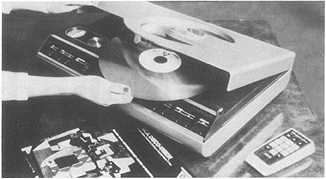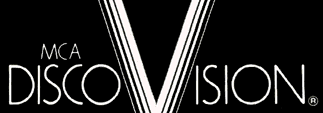|
Can current television sets be equipped to play recorded programs that could be purchased and stored like so many hi-fi discs? Manufacturers have been competing for a decade to be first to provide a practical answer. Trouble is, both videotapes and films are too expensive to produce for the mass market. Standard long-playing records, which can be stamped out by the millions, cannot carry all of the information necessary to produce TV images and sounds; millions of electrical signals are required every second to create a TV picture.
Almost simultaneously, scientists in the U.S. and Europe have finally overcome the problem of combining the information capacity of videotape with the lost cost of phonograph records. Their electronic hybrid is called the video discs - a relatively inexpensive record that can be played through a TV set to show everything from major Hollywood movies to educational and cultural features. By the end of 1976, both RCA and a team composed of the N.V. Philips Co. in The Netherlands and MCA, the California entertainment conglomerate, plan to market their systems in the U.S.
 At first glance, RCA's SelectaVision and Philips-MCA's Disco-Vision look virtual identical. Both systems use 12 inch LP-sized discs that play for 30 minutes on a side on high-speed turntables. Each is connected to the standard TV set by simply attaching a pair of wires to the antenna leads. There the similarities end. Behind the systems are entirely different technologies; the records used by one cannot be played on the turntables of the other. In Europe, a ten-minute disc system is already available manufactured by Teldec, a joint venture of West Germany's Telefunken and Britain's Decca companies. There are no plans to sell it in the U.S. At first glance, RCA's SelectaVision and Philips-MCA's Disco-Vision look virtual identical. Both systems use 12 inch LP-sized discs that play for 30 minutes on a side on high-speed turntables. Each is connected to the standard TV set by simply attaching a pair of wires to the antenna leads. There the similarities end. Behind the systems are entirely different technologies; the records used by one cannot be played on the turntables of the other. In Europe, a ten-minute disc system is already available manufactured by Teldec, a joint venture of West Germany's Telefunken and Britain's Decca companies. There are no plans to sell it in the U.S.
RCA's engineers opted for a relatively simple turntable. A major innovation is the metal-coated record, which is covered with a spiral grove only 0.00018 inches side - less than a tenth as thick as a human hair. In ordinary LPs, the grove encodes the sound; as the pickup needle runs over its "hills and dales," the needle is forced to vibrate at the same frequencies as the recorded sound. Translated into electrical pulses and amplified, the vibrations drive the loudspeaker. By Contrast, RCA's SelectaVision does not depend on mechanical vibrations. The disc's grove serves only to guide a sapphire stylus over a series of irregularly spaced slots in the groove. The slots are so small (up to 84,000 per inch) they must be etched into the master discs by an extremely fine, high powered beam of electrons. Yet variations in the width and spacing of the slots contain all the information necessary to reproduce a program in color (with stereo sound if desired). As the record spins at 450 rpm, a metallic strip on the back of the stylus "reads" the constantly changing electrical capacitance - a measure of the capacity to hold an electrical charge -= between the stylus and the disc's slotted surface. The varying capacitance is electronically transformed into picture and sound.
Philips-MCA has taken a different approach. Its aluminum-coated, plastic record, stamped from a master disc that has been etched by a laser beam, is covered with billions of microscopic pits. Variations in pit size encode the video and sound messages. For playback, a sharply focused beam from a low-powered (one-thousandth of a watt) helium-neon laser scans the disc as it whirls around at 1800 rpm. The laser beam flickers as it is reflected from the record's pocked surface, and the flickering is detected by a photosensitive cell, like that used in photographic exposure meters, which in turn converts it into electrical impulses that are changed into image and sound.
With its simpler turntable, RCA hopes to keep costs down to $400 for its player, v. a projected price of $500 for the Philips-MCA machine. Moreover, the RCA records will be usable on both sides for a full hour's playing time whereas the Philips-MCA disc plays on only one. On the other hand, the Philips-MCA system needs no stylus; its disc, scanned only by light, should have an indefinite lifetime. RCA's stylus wears as it makes contact with the discs and must be replaced every 300 hours (estimated cartridge cost: $10); the discs also wear out after some 300 plays.
Philips-MCA's laser system as an added attraction. By letting the laser beam circle over the same portion of the track, the player can freeze a single frame (it takes one revolution to make one picture). It can also run the images in slow motion and even go backward with only the push of a button - all potentially valuable features for educational programs. Each competitor is convinced that its approach is superior. But about one point there is no disagreement; either system could signal a major change in home entertainment habits.
|

 At first glance, RCA's SelectaVision and Philips-MCA's Disco-Vision look virtual identical. Both systems use 12 inch LP-sized discs that play for 30 minutes on a side on high-speed turntables. Each is connected to the standard TV set by simply attaching a pair of wires to the antenna leads. There the similarities end. Behind the systems are entirely different technologies; the records used by one cannot be played on the turntables of the other. In Europe, a ten-minute disc system is already available manufactured by Teldec, a joint venture of West Germany's Telefunken and Britain's Decca companies. There are no plans to sell it in the U.S.
At first glance, RCA's SelectaVision and Philips-MCA's Disco-Vision look virtual identical. Both systems use 12 inch LP-sized discs that play for 30 minutes on a side on high-speed turntables. Each is connected to the standard TV set by simply attaching a pair of wires to the antenna leads. There the similarities end. Behind the systems are entirely different technologies; the records used by one cannot be played on the turntables of the other. In Europe, a ten-minute disc system is already available manufactured by Teldec, a joint venture of West Germany's Telefunken and Britain's Decca companies. There are no plans to sell it in the U.S.